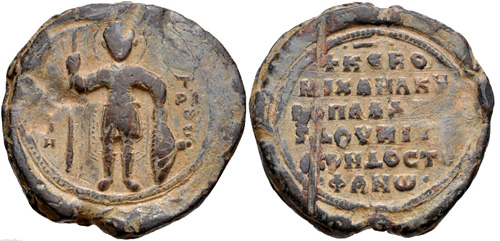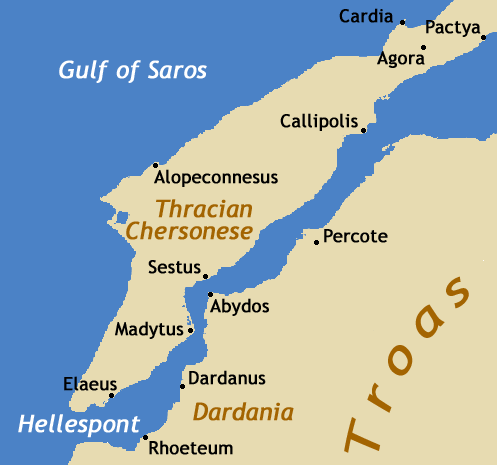|
Domentziolus (brother Of Phocas)
Domentziolus ( el, ќФќњќЉќµќљѕД пњљпњљќњќїќњѕВ) or Domnitziolus (ќФќњќЉќљќєѕДќґќѓќњќїќњѕВ) was a brother of the Byzantine emperor Phocas (r. 602вАУ610). Phocas and his family were likely of Thraco-Roman origin.Bury (2009), p. 197 Phocas and Domentziolus' mother was named Domentzia. A third brother is known, named Comentiolus. In 603, Phocas appointed Domentziolus as his ''magister officiorum'', a post he continued to hold throughout Phocas' reign. In 610, facing the revolt of Heraclius, Domentziolus was sent by Phocas to man the Anastasian Wall. When he heard however that Heraclius' fleet had reached Abydos, he fled to Constantinople la, Constantinopolis ota, ўВЎ≥ЎЈўЖЎЈўКўЖўКўЗ , alternate_name = Byzantion (earlier Greek name), Nova Roma ("New Rome"), Miklagard/Miklagarth (Old Norse), Tsargrad ( Slavic), Qustantiniya (Arabic), Basileuousa ("Queen of Cities"), Megalopolis (" .... After the overthrow and execution of Phocas, he too was executed on the orders of Heraclius, but his a ... [...More Info...] [...Related Items...] OR: [Wikipedia] [Google] [Baidu] |
Byzantine Emperor
This is a list of the Byzantine emperors from the foundation of Constantinople in 330 AD, which marks the conventional start of the Eastern Roman Empire, to its fall to the Ottoman Empire in 1453 AD. Only the emperors who were recognized as legitimate rulers and exercised sovereign authority are included, to the exclusion of junior co-emperors (''symbasileis'') who never attained the status of sole or senior ruler, as well as of the various usurpers or rebels who claimed the imperial title. The following list starts with Constantine the Great, the first Christian emperor, who rebuilt the city of Byzantium as an imperial capital, Constantinople, and who was regarded by the later emperors as the model ruler. It was under Constantine that the major characteristics of what is considered the Byzantine state emerged: a Roman polity centered at Constantinople and culturally dominated by the Greek East, with Christianity as the state religion A state religion (also called relig ... [...More Info...] [...Related Items...] OR: [Wikipedia] [Google] [Baidu] |
Curopalates
''KouropalatƒУs'', Latinized as ''curopalates'' or ''curopalata'' ( el, ќЇќњѕЕѕБќњѕАќ±ќїќђѕДќЈѕВ, from lat, cura palatii "he one incharge of the palace"). and Anglicized as curopalate, was a Byzantine court title, one of the highest from the time of Emperor Justinian I to the Komnenian period in the 12th century.. The female variant, held by the spouses of the ''kouropalatai'', was ''kouropalatissa''. History and nature of the title The title is first attested (as ''curapalati'') in the early 5th century, as an official of '' vir spectabilis'' rank under the ''castrensis palatii'', charged with the maintenance of the imperial palace (cf. Western European "majordomo"). When Emperor Justinian I () made his nephew and heir Justin II ''curopalates'' in 552, however, the office took on new significance, and became one of the most exalted dignities, ranking next to ''Caesar'' and '' nobilissimus'' and, like them, reserved initially for members of the imperial family. Unlike them, howev ... [...More Info...] [...Related Items...] OR: [Wikipedia] [Google] [Baidu] |
7th-century Byzantine People
The 7th century is the period from 601 (DCI) through 700 ( DCC) in accordance with the Julian calendar in the Common Era. The spread of Islam and the Muslim conquests began with the unification of Arabia by Muhammad starting in 622. After Muhammad's death in 632, Islam expanded beyond the Arabian Peninsula under the Rashidun Caliphate (632вАУ661) and the Umayyad Caliphate (661вАУ750). The Muslim conquest of Persia in the 7th century led to the downfall of the Sasanian Empire. Also conquered during the 7th century were Syria, Palestine, Armenia, Egypt, and North Africa. The Byzantine Empire suffered setbacks during the rapid expansion of the Caliphate, a mass incursion of Slavs in the Balkans which reduced its territorial limits. The decisive victory at the Siege of Constantinople in the 670s led the empire to retain Asia Minor which assured the existence of the empire. In the Iberian Peninsula, the 7th century was known as the ''Siglo de Concilios'' (century of councils) ... [...More Info...] [...Related Items...] OR: [Wikipedia] [Google] [Baidu] |
Executed Byzantine People
Capital punishment, also known as the death penalty, is the state-sanctioned practice of deliberately killing a person as a punishment for an actual or supposed crime, usually following an authorized, rule-governed process to conclude that the person is responsible for violating norms that warrant said punishment. The sentence ordering that an offender is to be punished in such a manner is known as a death sentence, and the act of carrying out the sentence is known as an execution. A prisoner who has been sentenced to death and awaits execution is ''condemned'' and is commonly referred to as being "on death row". Crimes that are punishable by death are known as ''capital crimes'', ''capital offences'', or ''capital felonies'', and vary depending on the jurisdiction, but commonly include serious crimes against the person, such as murder, mass murder, aggravated cases of rape (often including child sexual abuse), terrorism, aircraft hijacking, war crimes, crimes against h ... [...More Info...] [...Related Items...] OR: [Wikipedia] [Google] [Baidu] |
610 Deaths
61 may refer to: * 61 (number) * one of the years 61 BC, AD 61, 1961, 2061 * In some countries, a slang name for the Cyrillic letter –Ђ * '' 61*'', a 2001 American sports drama film * "Sixty One", a song by Karma to Burn from the album ''Mountain Czar ''Mountain Czar'' is an EP by the instrumental stoner rock band Karma to Burn. It was released in 2016 by SPV and Rodeostar Records. Unlike their previous release ''Arch Stanton'', ''Mountain Czar'' is not exclusively instrumental, with one t ...'', 2016 See also List of highways numbered 61 {{Numberdis ... [...More Info...] [...Related Items...] OR: [Wikipedia] [Google] [Baidu] |
6th-century Births
The 6th century is the period from 501 through 600 in line with the Julian calendar. In the West, the century marks the end of Classical Antiquity and the beginning of the Middle Ages. The collapse of the Western Roman Empire late in the previous century left Europe fractured into many small Germanic kingdoms competing fiercely for land and wealth. From the upheaval the Franks rose to prominence and carved out a sizeable domain covering much of modern France and Germany. Meanwhile, the surviving Eastern Roman Empire began to expand under Emperor Justinian, who recaptured North Africa from the Vandals and attempted fully to recover Italy as well, in the hope of reinstating Roman control over the lands once ruled by the Western Roman Empire. In its second Golden Age, the Sassanid Empire reached the peak of its power under Khosrau I in the 6th century.Roberts, J: "History of the World.". Penguin, 1994. The classical Gupta Empire of Northern India, largely overrun by the Huna, ended ... [...More Info...] [...Related Items...] OR: [Wikipedia] [Google] [Baidu] |
Theodore Of Syceon
Saint Theodore of Sykeon (Greek: ќШќµѕМќіѕЙѕБќњѕВ ѕМ ќ£ѕЕќЇќµѕОѕДќЈѕВ) was a revered Byzantine ascetic, who lived between the first half of the 6th century and the thirteenth year of the Emperor Heraclius' rule (i. e. 623) in the early 7th century. His hagiography, written after 641, is a key primary source for the reign of Emperor Heraclius (r. 610вАУ641). His feast day is April 22. Life Early life Theodore was born in Sykeon, a village in Galatia. The public highway of the imperial post ran through this village, and on the road stood an inn kept by a very beautiful girl, Mary, her mother, Elpidia, and a sister Despoinia. And these women lived in the inn and followed the profession of courtesans. Theodore was the son of Mary and Cosmas, who had become popular in the Hippodrome in the corps of those who performed acrobatic feats on camels and was appointed to carry out the Emperor's orders. When he was about twelve years old an epidemic of bubonic plague fell upon the village and ... [...More Info...] [...Related Items...] OR: [Wikipedia] [Google] [Baidu] |
Domentziolus (nephew Of Phocas)
Domentziolus ( el, ќФќњќЉќµќљѕДќґќѓќњќїќњѕВ) or Domnitziolus (Greek: ќФќњќЉќљќєѕДќґќѓќњќїќњѕВ) was a nephew of the Byzantine emperor Phocas ( r. 602вАУ610), appointed '' curopalates'' and general in the East during his uncle's reign.. He was one of the senior Byzantine military leaders during the opening stages of the ByzantineвАУSassanid War of 602вАУ628. His defeats opened the way for the fall of Mesopotamia and Armenia and the invasion of Anatolia by the Persians. In 610, Phocas was overthrown by Heraclius, and Domentziolus was captured but escaped serious harm. Biography Background The exact parentage of Domentziolus is unclear: Phocas had two known brothers, Comentiolus and another also named Domentziolus, who has sometimes been suggested as the younger Domentziolus's father. Shortly after the accession of Phocas, in 603, the younger Domentziolus was raised to the titles of '' vir gloriosissimus'', '' patricius'' and '' curopalates''. General in the East Domentziolus, howe ... [...More Info...] [...Related Items...] OR: [Wikipedia] [Google] [Baidu] |
Constantinople
la, Constantinopolis ota, ўВЎ≥ЎЈўЖЎЈўКўЖўКўЗ , alternate_name = Byzantion (earlier Greek name), Nova Roma ("New Rome"), Miklagard/Miklagarth ( Old Norse), Tsargrad ( Slavic), Qustantiniya (Arabic), Basileuousa ("Queen of Cities"), Megalopolis ("the Great City"), ќ†ѕМќїќєѕВ ("the City"), Kostantiniyye or Konstantinopolis (Turkish) , image = Byzantine Constantinople-en.png , alt = , caption = Map of Constantinople in the Byzantine period, corresponding to the modern-day Fatih district of Istanbul , map_type = Istanbul#Turkey Marmara#Turkey , map_alt = A map of Byzantine Istanbul. , map_size = 275 , map_caption = Constantinople was founded on the former site of the Greek colony of Byzantion, which today is known as Istanbul in Turkey. , coordinates = , location = Fatih, ƒ∞stanbul, Turkey , region = Marmara Region , type = Imperial city , part_of = , length = , width ... [...More Info...] [...Related Items...] OR: [Wikipedia] [Google] [Baidu] |
Phocas
Phocas ( la, Focas; grc-gre, ќ¶ѕЙќЇќђѕВ, Ph≈Нk√°s; 5475 October 610) was Eastern Roman emperor from 602 to 610. Initially, a middle-ranking officer in the Eastern Roman army, Phocas rose to prominence as a spokesman for dissatisfied soldiers in their disputes with the court of the Emperor Maurice. When the army revolted in 602, Phocas emerged as the natural leader of the mutiny. The revolt proved to be successful and led to the capture of Constantinople and the overthrow of Maurice on 23 November 602 with Phocas declaring himself emperor on the same day. Phocas deeply mistrusted the uncooperative elite of Constantinople to whom he was a usurper and a provincial boor. He, therefore, attempted to base his regime on relatives whom he installed in high military and administrative positions. He immediately faced multiple challenges in domestic and foreign affairs to which he responded with little success. He dealt with domestic opposition with increasing ruthlessness which alie ... [...More Info...] [...Related Items...] OR: [Wikipedia] [Google] [Baidu] |
Abydos (Hellespont)
Abydos ( grc, бЉМќ≤ѕЕќіќњѕВ, la, Abydus) was an ancient city and bishopric in Mysia. It was located at the Nara Burnu promontory on the Asian coast of the Hellespont (the straits of Dardanelles), opposite the ancient city of Sestos, and near the city of √Зanakkale in Turkey. Abydos was founded in c. 670 BC at the most narrow point in the straits, and thus was one of the main crossing points between Europe and Asia, until its replacement by the crossing between Lampsacus and Kallipolis in the 13th century, and the abandonment of Abydos in the early 14th century. In Greek mythology, Abydos is presented in the myth of Hero and Leander as the home of Leander. The city is also mentioned in ''Rodanthe and Dosikles'', a novel written by Theodore Prodromos, a 12th-century writer, in which Dosikles kidnaps Rodanthe at Abydos. Archaeology In 1675, the site of Abydos was first identified, and was subsequently visited by numerous classicists and travellers, such as Robert Wood, Richa ... [...More Info...] [...Related Items...] OR: [Wikipedia] [Google] [Baidu] |









